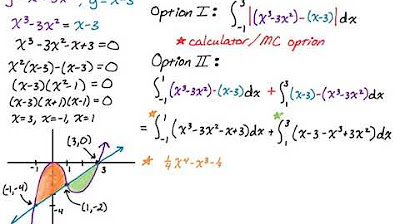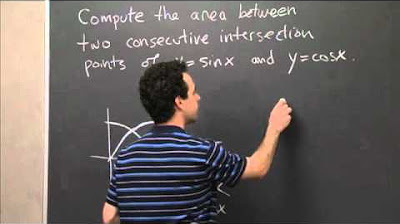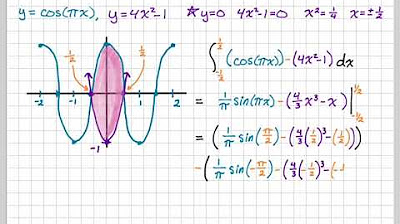Area Between y=x^3 and y=3x-2 | MIT 18.01SC Single Variable Calculus, Fall 2010
TLDRIn this recitation, the professor introduces the concept of using definite integrals to find areas between two curves, specifically between y=x^3 and y=3x-2. The challenge lies in identifying the interval of integration by finding the intersection points of the curves. Through solving the cubic equation x^3 - 3x + 2 = 0, the intersections at x=1 and x=-2 are determined. The area calculation involves integrating the difference of the functions from -2 to 1, resulting in a straightforward polynomial integration that yields the area of the bounded region as 6 and 3/4 square units.
Takeaways
- 📚 The lecture discusses the application of definite integrals to find areas of regions bounded by curves.
- 🔍 Students are encouraged to pause the video and try to figure out the problem of finding the area between the curves y = x^3 and y = 3x - 2 themselves.
- 📈 The key to solving the problem is to determine the points of intersection between the two given curves.
- 🧩 To find the intersection points, one must solve the equation x^3 = 3x - 2, which simplifies to x^3 - 3x + 2 = 0.
- 🔑 Recognizing that x = 1 is a root of the equation allows for factoring, leading to the factorization of (x - 1)(x^2 + x - 2).
- 📐 The intersection points are found to be at x = 1 and x = -2, which helps in visualizing the bounded region.
- 📉 The area of interest is between the two curves from x = -2 to x = 1, where y = x^3 is the upper curve and y = 3x - 2 is the lower curve.
- ✂️ The integral to find the area is set up as the integral from -2 to 1 of (x^3 - (3x - 2)) dx.
- 📝 The integral calculation involves integrating the polynomial functions and then evaluating from the lower to the upper limit of integration.
- 🧮 The final step involves arithmetic to find the numerical value of the integral, which represents the area of the region.
- 🎯 The final computed area of the region bounded by the curves is 6 and 3/4 square units.
Q & A
What is the main topic discussed in the recitation?
-The main topic discussed in the recitation is the application of definite integrals to find areas of regions bounded by two curves.
What is the specific example given to demonstrate the use of definite integrals for finding areas?
-The specific example given is to find the area of the region bounded between the curves y = x^3 and y = 3x - 2.
Why is it necessary to find the points of intersection between the two curves?
-It is necessary to find the points of intersection to determine the interval over which the definite integral will be computed to find the area of the bounded region.
What is the equation set up to find the points of intersection between the two curves?
-The equation set up to find the points of intersection is x^3 = 3x - 2, which is rearranged to x^3 - 3x + 2 = 0.
How is the cubic equation x^3 - 3x + 2 = 0 simplified?
-The cubic equation is simplified by recognizing that x = 1 is a root, which allows the equation to be factored as (x - 1)(x^2 + x - 2) = 0.
What are the points of intersection found for the two curves?
-The points of intersection are at x = 1 with y = 1, and at x = -2 with y = -8.
Why is it important to know which curve is on top and which is on the bottom when calculating the area?
-Knowing which curve is on top and which is on the bottom is important to determine the correct order of the curves when setting up the integrand for the definite integral.
What is the integrand for the definite integral that calculates the area of the region?
-The integrand for the definite integral is x^3 - (3x - 2), representing the difference in height between the two curves.
What are the limits of integration for the area calculation?
-The limits of integration are from x = -2 to x = 1, which are the points of intersection found for the two curves.
How is the final area of the region calculated?
-The final area is calculated by integrating the integrand from the lower limit to the upper limit and simplifying the resulting expression to get the numerical value of the area.
What is the final area of the region bounded by the two curves?
-The final area of the region is 6 and 3/4 square units, after performing the integration and simplifying the result.
Outlines
📚 Introduction to Definite Integrals for Area Calculation
The professor begins by welcoming students back to recitation and introduces the concept of using definite integrals to find areas of regions bounded by curves. An example is given where students are asked to find the area between y = x^3 and y = 3x - 2 without specified endpoints. The professor suggests students to visualize the problem, determine the interval of integration, and find the intersection points of the two curves. The video encourages students to pause and attempt the problem before continuing with the solution.
🔍 Solving the Intersection and Calculating the Area
After identifying the endpoints of the integration interval by solving the equation x^3 = 3x - 2, the professor explains the process of finding the intersection points of the two curves. It is revealed that x = 1 and x = -2 are the points of intersection. The professor then describes the region of interest and clarifies which curve is on top and which is on the bottom. The area calculation involves integrating the difference between the top curve (x^3) and the bottom curve (3x - 2) from x = -2 to x = 1. The integration process is detailed, with the polynomials being integrated term by term. The final step involves arithmetic to find the numerical value of the area, which the professor humorously admits is where mathematicians might falter. The final area of the region is calculated to be 6 and 3/4 square units.
Mindmap
Keywords
💡Definite Integrals
💡Area of a Region
💡Curves
💡Integration Interval
💡Intersection Points
💡Cubic Equation
💡Roots
💡Factoring
💡Integration
💡Polynomial
💡Arithmetic
Highlights
Introduction to using definite integrals to find areas of regions bounded by curves.
Example problem presented: compute area between y=x^3 and y=3x-2 without given endpoints.
Challenge of determining the interval of integration without explicit endpoints.
Finding intersection points by solving x^3 = 3x - 2 to determine the bounds of integration.
Identification of x=1 as an easily recognizable root using rational root theorem or trial.
Factoring out (x-1) from the cubic equation to simplify finding other roots.
Performing polynomial division to find the factored form of the equation.
Revealing the complete factorization of the cubic equation as (x-1)^2(x+2)=0.
Determining intersection points at x=1 and x=-2, with the latter being a tangent point.
Visual representation of the curves and the bounded region for area calculation.
Understanding which curve is on top and which is on the bottom for integral setup.
Setting up the integral of (x^3 - (3x - 2)) from x=-2 to x=1 to find the area.
Integration of the polynomial to calculate the area under the curves.
Step-by-step integration process: integrating x^3, -3x, and +2 separately.
Substitution of the integration limits to evaluate the definite integral.
Arithmetic calculation of the definite integral result.
Final area calculation result: 6 and 3/4 square units.
Reflection on the importance of understanding the problem's visual representation before integration.
Discussion on the ease of integration once the setup is correctly understood.
Transcripts
Browse More Related Video

Area Between Two Curves with Multiple Regions: y = x^3-3x^2 and y = x-3

Area Between the Graphs of Sine and Cosine | MIT 18.01SC Single Variable Calculus, Fall 2010

Finding a Horizontal Line (y=k) to Divide a Region into Two Equal Parts Using Calculus

Area Between Curves: Integrating with Respect to y (Example 2)

Area Between Curves: y = cos(pi*x), y = 4x^2 -1

Volume with cross sections: intro | Applications of integration | AP Calculus AB | Khan Academy
5.0 / 5 (0 votes)
Thanks for rating: